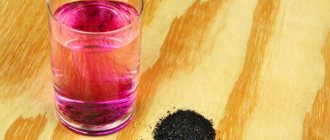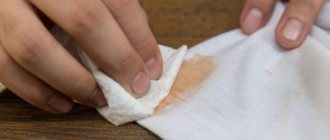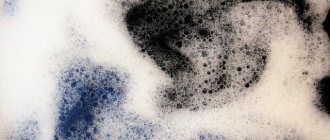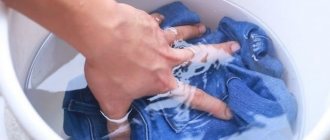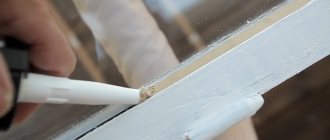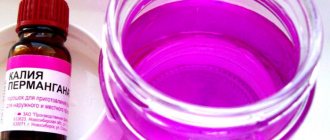Potassium permanganate is very quickly absorbed into porous surfaces and colors them intensely, so stains on hands cannot be removed with ordinary water. For this, peroxide is used in pure form or mixed with vinegar, ethyl alcohol, citric and ascorbic acid, ammonium sulphide and laundry soap. White spirit can be used as a chemical solvent, and pure clay can be used as a mechanical cleaning method. Fresh stains are removed with mustard powder and hot water.
The main task is to wash potassium permanganate from your hands in such a way that the colored stains go away as quickly as possible, and at the same time the skin is damaged as little as possible. To do this, first of all, you should use safe folk methods and remedies that do not have high activity and speed of removing stains, but certainly will not damage the skin.
Why potassium permanganate leaves marks on hands
Potassium permanganate is used in everyday life as a very active disinfectant.
Color intensity of potassium permanganate solutions
Potassium permanganate literally burns out any harmful bacteria, leaving behind sterile surfaces. But at the same time, potassium permanganate has a very detrimental effect on the skin of the human body, being deeply absorbed into it and strongly staining it.
If the concentration of the solution was very high, then there is a possibility of very unpleasant brown spots and even burns.
Potassium permanganate burn
It is almost impossible to wash off potassium permanganate from the skin with ordinary water, because it is very deeply absorbed into it and even reacts with the epithelium. Other methods must be used for cleaning.
Material on topic! Why do walnuts stain leather when cleaning, and how to get rid of stains.
How else can you wash off potassium permanganate?
If you don’t have alcohol or peroxide on hand, use other means that are no less effective.
Option 1
You can solve the problem of how to wash potassium permanganate off your hands in this way:
Important! Instead of lemon, you can use citric acid. This way you will not only clean your hands, but also whiten your nails.
Option 2
Prepare the following cleaning product that will not only remove unsightly marks from your hands, but also easily clean hard surfaces if necessary:
We hope that our article was useful to you and you now know how to wash potassium permanganate from the skin of your hands. But remember, so as not to waste your time next time, wear gloves before you decide to use potassium permanganate crystals.
Preparing the skin for stain removal
Before you start washing potassium permanganate from your skin, you need to prepare the skin. Preparation consists of washing off residual traces of potassium permanganate from the upper layers of the skin. They must be removed so that the active ingredients described below react directly with the stains.
First of all, you need to wash your hands under warm water using toilet or laundry soap. After the colored water stops coming off the skin, you need to arm yourself with pumice.
Advice! You should not rub your skin vigorously with a pumice stone, because there is a risk of damaging already burned skin.
The result of the manipulations performed will be skin prepared for further cleaning, in the upper layers of which there is no potassium permanganate solution left.
Means for removing stains from fabric
You won’t be able to simply wash a stain containing potassium permanganate in a washing machine. After all, when the substance gets on the fabric, a kind of chemical burn is formed, damaging the structure of the fibers. In such circumstances, we are only talking about how to remove an unsightly brown stain.
ARTICLE FOR YOU
How and with what to wash, remove unpleasant odors and urine stains from clothes and linen
For this purpose, many housewives use:
- acids - oxalic, acetic or citric;
- sodium hyposulfite;
- curdled milk;
- whey;
- baking soda;
- ammonia;
- hydrogen peroxide.
Oxalic acid is easy to buy at the pharmacy. It is commercially available in the form of crystalline powder.
How to use:
- To prepare a cleaning solution, mix 100 ml of heated water and 1 tsp. l. crystals.
- The resulting liquid is applied to the trace of potassium permanganate and left for a quarter of an hour.
- Then the item must be washed in warm water.
Means for removing stains from fabric
This technique is good for getting rid of dark spots on white textiles. Sodium hyposulfite, which is found in pharmacies, has a similar effect:
- It is diluted with water in a ratio of 1:9.
- Soak the soiled fabric in the resulting solution for a quarter of an hour.
- Darkened residues of dirt are washed off without leaving any residue.
Removing stains with lemon juice
Citric acid has excellent oxidizing properties, so it is often used to remove stains from natural dyes. It also copes with traces of potassium permanganate, and even old stains can be easily removed with its help.
- The stained area on the clothing is moistened with warm water and sprinkled with citric acid crystals.
- After 30 minutes, remove any remaining acid with warm water.
- If after such treatment the streaks are still noticeable, the procedure is repeated.
Contaminated colored items made from thin fabrics, tulle, blouses or shirts are cleaned with lactic acid. In this case, potassium permanganate stains are soaked in a basin with yogurt or whey for several hours, and then the clothes are washed in the usual way. This method is suitable for removing dirt from woolen and children's clothes, T-shirts or trousers.
How can you wash potassium permanganate?
Another way to clean delicate textiles is to bleach with hydrogen peroxide. A cotton pad is soaked in this substance and the darkened areas are wiped. Then the item is washed in cool water.
To remove potassium permanganate stains from a white tablecloth, baking soda is useful. It is diluted with a small volume of warm water to a mushy state and rubbed into the affected areas.
ARTICLE FOR YOU
How and how to wash and remove stains from stationery barcode corrector from clothes
To make the process more efficient, use a combination of soda and ammonia. To do this, dissolve 2 tbsp in 5 liters of water. l. ammonia and 5 tbsp. l. soda powder.
The affected tablecloth or towels are soaked in this solution. If the fabric is thick enough, boiling can be used. After removing traces of dirt, items treated with soda should be washed thoroughly.
Hydrogen peroxide
To remove potassium permanganate stains from jeans or a bedspread, use a mixture of powdered citric acid and hydrogen peroxide:
- The components are mixed in equal quantities.
- Cover contaminated areas evenly.
- Wait 10 minutes.
- They wash things.
Whiteness for bleaching
Traditional methods for removing potassium permanganate
You can start removing stains with available products that you can find in everyday life. They are accessible, inexpensive, and therefore can be quickly used in case of severe contamination with potassium permanganate.
A mixture of hydrogen peroxide and vinegar
Table vinegar and pharmaceutical peroxide are mixed together in equal proportions.
Hydrogen peroxide and table vinegar
Stains on hands or nails should be wiped with the resulting liquid using a cotton pad or a clean cloth. You can wash potassium permanganate off your hands with this solution as soon as possible.
With this solution you can wash not only potassium permanganate from the skin, but also traces of pigmenting henna from your hands or dirt after working in the garden.
Ethanol
Medical alcohol, strong alcoholic drinks, alcohol antiseptics and some types of hairspray can be used as an alcohol solvent. The method of applying liquids is similar to that described above.
Ethanol
Important! Do not use alcohol on your skin if you have a chemical burn.
Lemon acid
A concentrated solution of citric acid prepared in warm water will help discolor potassium permanganate stains.
Lemon acid
If you don't have a bag of citric acid powder on hand, you can use regular lemon. To do this, the fruit is cut into two parts, the spots are rubbed on each half until the color begins to disappear. Residues of citric acid are washed off with toilet soap and warm water.
This is interesting! Lemon or citric acid will help deal with stains from brilliant green and dirt from oil cleaning.
Ascorbic acid
You can also significantly discolor stains with a solution of ascorbic acid, which is sold in any pharmacy.
Ascorbic acid
During the day, stains should be wiped with liquid using a cloth or cotton wool. Residues of acid are washed off with plain water and soap.
Hydrogen peroxide
Concentrated hydrogen peroxide can discolor brown and purple stains from potassium permanganate in one application.
Hydrogen peroxide
You need to use this product very carefully so that the peroxide does not burn your hands even more. This method should not be used on children's delicate skin.
Note! Find out which products are suitable for cleaning children's skin from various stains, including marker marks.
Ammonium sulfide
Ammonium sulphide solution also has the ability to discolor traces of potassium permanganate.
Ammonium sulfide
Apply a small amount of liquid to the stains and rub in gently. The remaining solution is washed off under running hot water.
Intensive products recommended for combating traces of potassium permanganate
There are several proven components that can remove traces of potassium permanganate from the skin:
- Take 9% vinegar and 3% hydrogen peroxide in equal proportions and mix. Soak a cotton pad in the solution and use gentle movements directed in one direction to try to wipe off the stains.
Advice: Some craftsmen recommend washing off potassium permanganate with potato juice, but this approach will only achieve the opposite effect. Stains from purple will turn blue, and will be even more durable.
- Medical alcohol works well on fresh and old stains from purple antiseptic. First, apply the composition to the affected areas, then soak a cotton pad in the product and begin to scrub off the dirt with intense movements. If the formations are fresh, then you won’t have to rub too hard; the product will dissolve and disappear on its own.
- Sometimes potassium permanganate needs to be removed not only from the surface of the hands, but also from under the nails. Lemon or its juice can help with this. Cut the fruit into halves and begin to rub the stains with the cut. For some time, the fingertips need to be immersed in the pulp of the fruit. Then wash your hands with warm water without soap and repeat the procedure. You will first have to dilute citric acid with water, and to clean your nails, it is advisable to prepare a warm bath with dissolved powder.
- From laundry soap you can prepare a composition with which potassium permanganate can be washed not only from the surface of your hands, but also from soiled hard surfaces. Rub baby or laundry soap on a grater, fill the shavings with hot water and stir with a fork or whisk. You should get a homogeneous paste. Dissolve two tablespoons of soda and a couple of drops of any essential oil in it. Apply the active composition to the areas of skin with stains several times, each time rinsing it well with water.
We recommend: What is the easiest way to remove rust from clothes yourself?
- To reduce the brightness of stains, it is recommended to use a solution of ascorbic acid. It acts very gently, although it does not completely remove purple marks.
- Pure 3% hydrogen peroxide will also help remove unwanted marks, but you need to act carefully, otherwise you can cause a chemical burn.
- If you don't have anything else on hand, you can try white spirit. A universal solvent, even if it does not completely remove it, will noticeably lighten the stains.
After using the listed components, it is necessary to treat the skin with a nourishing or moisturizing cream, otherwise the tissue will begin to dry and peel. If the first approach fails to completely eliminate purple stains, you need to take a break, dry the skin, and then try again. It is strictly forbidden to apply active products and leave them on the skin for several hours. The spots from such exposure will go away, but in their place will come irritation and inflammatory processes.
Laundry soap is a proven remedy against potassium permanganate
Laundry soap, enhanced with other components, perfectly removes even deep stains from potassium permanganate, although this method may require a significant investment of time, including preparation and processing.
To prepare the product, you will need a bar of laundry and baby soap, some hot water, soda and a couple of drops of fragrant essential oil. Baby soap can be replaced with dish detergent.
The soap is grated on the finest grater, poured with hot water and mixed until a thick, homogeneous slurry is formed. After this, two tablespoons of soda are poured into the still warm substance and essential oil is added for scent.
Soap combined with baking soda is an excellent cleaning agent.
The prepared product has the consistency of a paste, which must be applied to potassium permanganate stains. After drying, the product is washed off your hands with hot water.
Advice! If after the first time the stains do not come off completely, the treatment should be repeated several times.
For cleaning bathtubs and sinks
To remove a blot from a hard surface, the latter must be tested for sensitivity to the selected product. Apply it to an inconspicuous corner of your bathtub or sink and make sure after half an hour that it has not damaged the integrity of the coating.
- For cleaning, you can choose any bleach; it copes quite well with such problems. It is enough to fill the bath with water so that it covers the stains, add a little bleach and leave it for 8-10 hours.
- Pour boiling water over grated laundry soap (half a bar 72%) and stir. After cooling, add 1 tbsp. l. soda + 1 tbsp. l. mustard powder + 2 tbsp. l. ammonia. This mixture will cope with many stains (you can even prepare the product for future use).
- Acids are suitable for this purpose, but not very aggressive ones (10% citric, acetic, oxalic).
- Hydrogen peroxide, either alone or mixed with table vinegar, whitens and removes stubborn potassium permanganate.
- Apply the soda paste to the stain for 15 minutes, then rub the stain with a sponge soaked in vinegar.
For acrylic bathtubs, cleaning methods are chosen even more carefully; in this case, it is better to give preference to specialized products.
These simple methods will help you deal with potassium permanganate stains. Do not forget that all work on cleaning surfaces must be carried out with gloves.
photo: depositphotos.com/Adam88xxx
Chemistry to help
If the above-described remedies do not produce the desired effect, you can try to wipe off potassium permanganate stains with a more active solvent, White Spirit.
White Spirit
This paint and varnish solvent perfectly removes stains and discolors potassium permanganate residues. To apply to the skin, you can use a cloth or cotton wool.
Note! In everyday life, the product is used quite often: to clean hands from paint or superglue, to clean windows from polyurethane foam and plastic window sills from silicone.
